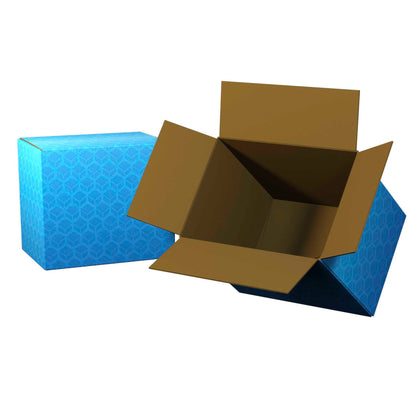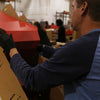

Choosing The Right Shipping Box
The right shipping box is a crucial part in delivering your goods. Boxes come with different shapes, sizes and strength to suit any need - from small packages that can be handled by one person or larger items best moved on foot for transportation purposes; there's an option just right for you.
Boxes have a huge impact on your supply chain. Why bother choosing the perfect package if it's going to end up getting damaged during shipping?
We all know how important it is to have the right shipping box for your business needs. This blog will help you make the right choice.
Table Of Contents
What Is Corrugated Board?
Corrugated board, which is a composite material produced from two or more sheets of paperboard, is the foundation of a corrugated box. The medium is the sheet that makes up the middle of a piece of corrugated board; it's given a wavelike, corrugated shape and then attached between two flat sheets known as the liner or linerboard. The flutes of the medium are the waves that make up the medium.
- Single-wall board is created by sandwiching one corrugating medium between two linerboards.
- Double-wall board is a heavy-duty box made out of two corrugating mediums and three linerboards. It is generally used for larger products like large appliances.
- Triple-wall board is made of three mediums and four linerboards. According to Walter Soroka's "The Illustrated Glossary of Packaging Terminoloy," triple-wall board is sturdy enough to replace timber in a variety of packaging applications. Including bulk containers and equipment packaging.
- Single-face corrugated board is primarily used as a cushioning material for things in other containers and is created by gluing the corrugating substance to a single linerboard.
Take a look at this other blog if you want more information about corrugated fiberboard.
Types of Corrugated Shipping Box Closures
A normal slotted container is the most common type of corrugated shipping box (RSC). All of the closure flaps of an RSC-style box are the same length—one-half of the box width. This implies that when the flaps are closed, the outside pair will meet in the middle, but not the inner flaps. Because there is very little scrap when the RSC is created, it is a comparatively affordable box type.
All of the closing flaps of a full overlap slotted container (FOL) are longer—as long as the box's width. This implies that the outside flaps will nearly fully overlap one other, resulting in extra layers of corrugated board and a robust, cushioned box. When the box is on its side, the overlapping flaps aid provide compressive strength.
A half slotted container (HSC) is similar to a regular slotted container (RSC), but with one flapless, "open" side.
RSCs, FOLs, and HSCs are all slotted containers, but there are also self-erecting boxes, Bliss boxes, telescope boxes, and folders that are less prevalent.
Shipping Carriers
There are several reasons why a firm could require shipping boxes, ranging from sending orders to external clients to addressing internal needs such as supply transfers and storage.
Shipping services in the United States not only charge based on the size and weight of the package being transported, but they also impose size and weight limits. Check that your box does not exceed the maximum dimensions, otherwise your shipment may have to be shipped through freight carrier.
Sizes and Shapes
Corrugated cardboard is used to make typical shipping boxes. You have a variety of forms and box strengths to pick from. You may want a more sturdy box depending on the size and weight of your product.
The most common box forms and strengths are shown here. There are, however, a plethora of other box kinds to pick from.
Box Sizes
The first step is to determine the size of your shipment box. Traditional rectangular and cube-shaped boxes are available, as well as extended forms and sizes for particular applications.
Cube Boxes
Cube boxes are perfect for storage. They have the same length on all edges and sides, making them square in shape with no curves or angles. This reduces the chance for damage during shipment. And that means you'll never need another box again.
Multi-Height Boxes
Multi-height boxes are a great way to provide different levels of storage in your home. You can choose between two, three or more options depending on the size and shape you need for any given space.
Long boxes
Long boxes are a must-have for shipping items that require extra space. The longer length of these types of cargo can accommodate larger packages or irregular shapes without worrying about them bumping into other containers on the way to their destination.
Tall boxes
When shipping items that are too tall to be put into a shorter box, the best option is one with ample depth and width. This will ensure your goods stay upright while staying secure during transport.
Telescopic boxes
Telescopic boxes are a great way to ship long items that may not fit into just one box. These types of shipping containers come in various sizes, so you can find the perfect match for your needs.
Side-loading boxes
Side-loading boxes are typically broad and narrow, having a loading or unloading entrance on one side. They might be in the form of a framed photo, a poster, or whatever else you like.
Box Strength
The edge crush test (ECT) for stacking strength and the Mullen Test for bursting weight are both often used to assess the strength of shipping boxes. Any corrugated shipping box's box manufacturer's certificate (BMC), a circular stamp that carries the manufacturer's name and other technical information, will include one of these two measurements.
The two most regularly used shipping box strengths are:
32 ECT
32 ECT can withstand a vertical compression of 32 pounds per square inch and is commonly used for stacking lesser weight goods.
200#
200# boxes are useful for medium-duty shipping because they have a bursting strength that is around 50% greater than 32 ECT boxes.
This can have an impact with the other packaging options for your product.
Burst Strength (Mullen) vs. ECT
What's the difference between the two box strength ratings? Boxes are put through a wide range of uses and still maintain their integrity. The size and weight can cause one type to fail, while another will keep on working perfectly fine even after being abused by heavy items in shipping process for years!
The burst strength of a box is determined by how much pressure it can withstand before breaking. The most common rating for this type or material, with about 200 pounds per square inch (psi) applied, has been tested to rupture at around 3693 psi. But that is well past what many people would consider "normal" levels.
Corrugated boxes are designed to withstand a certain amount of pressure before they burst. The Mullen test applies slow, steady hydraulic pressure on the face or sides and checks how long it takes for the material's integrity wear away enough that its linerboard component fails under these circumstances - which can happen at anywhere between 200lbs/sq inch up until 2 tons.
The burst strength is useful for predicting how a box will withstand forces when it is subjected to rough treatment. It is common in high-speed sorting facilities for this to happen. Where boxes—many of which contain inadequately secured loads—are expected to drop or slam into one another.
What Does It Mean For Boxes?
Shipping boxes that have been rated according to the Mullen test can withstand minor impacts and forces, making them perfect for small-package shipping.
We all know that corrugated boxes are great for packing and shipping, but did you also realize they can be tested to see how much weight these things hold? The edge crush test (ECT) is a way of predicting the compression strength of an item.
Developed many years ago by engineers who wanted something more direct than just looking at size or shape; this indicator was designed specifically so we would have better understanding when it comes down deciding what kind package will best suit our needs.
The ECT test is a measure of how stiff the board will be when standing up in its intended position. The procedure involves stacking pieces corrugated packaging material so that they are vertical and then testing for downward force required to crush them.
Boxes are often chosen for their stacking ability. The more exposure a box has been through, the stronger it will be when stacked up against other boxes and handled by warehouse employees who need only open one top-side corner before discovering what's inside--and if that doesn't work out too well then just rip them apart at either end with ease.
Product Delivery
Shipping is an essential but often overlooked part of business success. The right boxes can help you meet your needs, while providing safe and secure delivery for all customers - that's what we call a win-win!
With so many different shapes available on the market today, knowing which one will be best suited depends largely upon your needs. How much space they need to accommodate, whatever product or service they offer, as well any other relevant details like weight restrictions, etc.
Order Shipping Boxes From Bennett Packaging Today!
Whether you are looking for standard shipping boxes or custom shipping boxes, we have just what you need. From small packs to larger flat boxes, our products can accommodate a variety of products and services. Ordering from a supplier has it's benefits.
Our products are made with the highest quality materials available, so they will never fail when in use. We also offer environmentally-friendly options, so everyone wins. If you want a custom shipping box or a stock box, we can help you.
At Bennett Packaging, we know how important it is to choose the right type of shipping box for your needs—and that's exactly why we're here! Our team prides itself on offering customer satisfaction throughout every phase of business interaction - from purchase through delivery - which means that whatever shape or size you need to suit your particular product line is part of an overall service plan designed to fulfill your needs.
Frequently Asked Questions
How are the dimensions of a corrugated box written?
Length (the longest side) x Width (the shorter side) x Depth.
What are corrugated boxes made of?
Corrugated boxes are built of corrugated board, which is a composite material made up of paperboard layers made up of various elements. The middle corrugated layer (known as the medium) is placed between two layers of linerboard in single-wall corrugated board. The medium is frequently created from a semichemical stock, but the linerboard is usually made using the kraft process, which creates a stronger board. Recycled material can be found in variable quantities in both the medium and the linerboard.
What is an RSC box?
A regular slotted container, or RSC, is a corrugated box with closing flaps that are all the same length, one-half the width of the box. Which is the measurement of the opening's shorter side. The most common form of shipment box is this one.
What is an FOL box?
A full overlap slotted container (FOL) is similar to a regular shipping box (RSC). But it has longer flaps that overlap significantly more when closed, making the product more sturdy and cushioned. An FOL's flaps are the same length as the box's width.
What is a standard size shipping box?
The standard size shipping box has no specific requirements. When you look at your own company's packages, you'll see that they come in a variety of forms and sizes. Almost any shipping box necessity may be met with a box.
How do I know what size box I need?
Measure your goods to make sure you don't choose a box that's too tiny or too big, and remember to accommodate for extra padding space. To get the best fit for your goods, you may want to try a few different box sizes. Keep in mind the criteria of major U.S. shipping companies so you don't choose a box that is too big.
What is the cheapest size box to ship?
The lowest shipping size box varies depending on the shipping business and method you select. Smaller, lighter-weight boxes are often the most cost-effective to send. This is why, after padding is applied, it's crucial to evaluate several sizes and possibilities. Choosing the smallest box size possible might save your company a lot of money on both box and delivery charges.
Should I use a company like Packlane?
This is a great question, but you should dig into our blog post to learn more about ordering from online suppliers.




